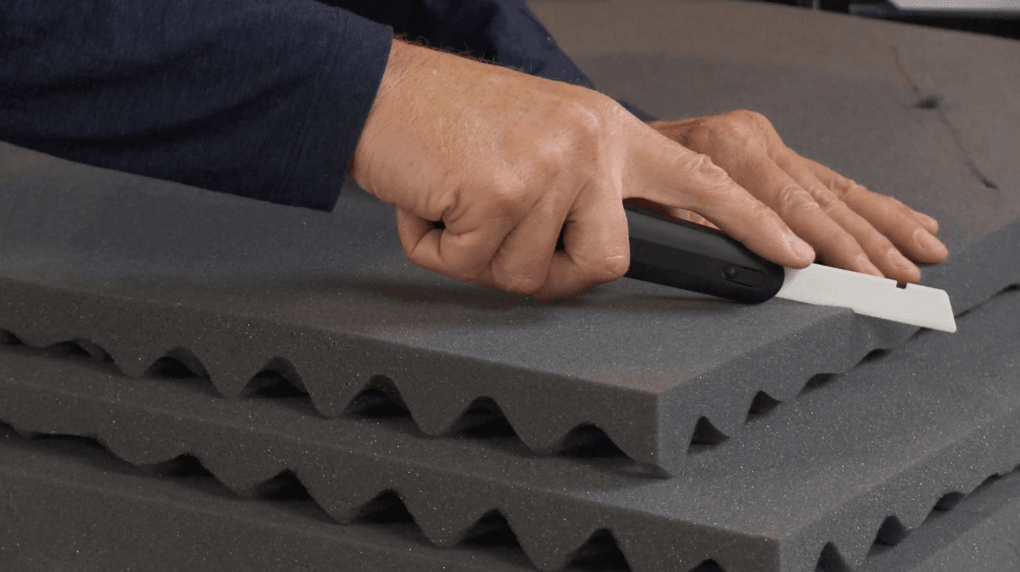Safer Foam Cutting Tools

Foam cutting tools that are specifically designed to work with different types of foam can make working with foam easy. But if you’re working with any of these types of foam, the only tool you need may already be in your tool box:
- Acoustic foam
- Spray foam insulation
- Rigid foam insulation
- Foam pipe insulation
- Foam underlayment
- Foam board
There are professional foam cutting tools on the market, such as hot wire knives used by crafters and foam sculptors, table saws with cutout and ceramic-coated blades used to cut rigid foam insulation, and Dremel tools to carve intricate details. The vertical-bladed foam cutting saw is the professional’s tool of choice, but unless you’re cutting a lot of foam on a routine basis, it’s hard to justify the investment in one of these saws, which easily cost several hundred dollars.
There’s another option, one that’ll make economic sense for most users and their foam-cutting jobs: a utility knife. The only problem with this relates to the nature of foam. It’s either rigid and slick, thus making it likely that knife slips will occur, or soft and squishy, which causes jagged cutting if your knife’s the least bit dull. Repeatedly snagging and releasing the knife puts you at risk of accidental injury.
Even worse, cutting foam quickly dulls knife blades, so you’ll need a knife that has blades that are easily replaced. The nature of the material and the need for a strong, sharp knife to cut it has led people to use dangerous tools, like utility knives with traditional blades. Some have even tried butcher knives.
Slice® industrial and utility knives are perfectly ground to a finger-friendly® edge that is sharp enough to cut both soft and rigid foams, yet safe to touch during blade replacement.
Choosing the Best Foam Cutting Tools
So, what’s the best tool to cut foam? That depends on the type of foam you’re cutting. First, consider the composition and density of the foam. Generally, the denser the material, the thinner blade you'll want in order to reduce drag. To easily cut softer foam, you need a knife that is strong and unlikely to bend during cutting.
Foam Insulation Cutting Tools
If you don’t need, or want, to invest in a foam insulation cutter, which easily costs several hundred dollars, one of our utility knives will serve you well. Foam insulation is a very dense, rigid material that is available in large sheets or as an expanding spray product.

Whether you’re cutting larger foam insulation sheets down to size or trimming overspray, you’ll need a thinner blade. Our 10490 Manual Metal-Handle Utility Knife or our 10491 Auto-Retractable Metal-Handle Utility Knife would work well in this application. We ship these knives with our rounded-tip blades as a safety measure, because the rounded tip reduces the likelihood of puncture injuries, but both of these handles are compatible with any of our Utility Blades, which include both a pointed-tip and serrated blade.
These knives also are excellent tools for cutting foam board (used to mount pictures) or foam underlayment (used to cushion hardwood floors). The 10490 Manual Metal-Handle Utility Knife is especially well-suited to these jobs, because the cutting depth of the blade can be adjusted to the depth of the foam board or underlayment. This reduces the risk of injury to yourself as well as damage to the material, since you won’t be exposing an excessive blade length.
Working With Softer Foams
Softer foams present a different set of cutting challenges. Whether you’re installing acoustic foam for insulation or soundproofing, protecting delicate electronic or photography equipment, or weatherproofing pipes with foam insulation, you need a tool that’s sharp, strong, and durable.
Soft foam tears easily, so you need a knife that’s sharp enough to slice right through it. In the case of thicker acoustic foam, you’ll also need a longer, stronger blade. Traditional blades are a bad option for cutting softer foams. Yes, they’re sharp. But that’s the problem. They’ll cut your skin just as easily as they cut the foam.
Slice’s finger-friendly safety blades are made from zirconium oxide, which is stronger than stainless steel. We use thicker blades and apply our proprietary grind, giving you a safe-to-touch blade that is less likely to bend, flex, or snap during cutting. You’ll get clean, straight cuts and your fingers will be safer.
Our 10559 Manual Industrial Knife and our 10560 Auto-Retractable Industrial Knife offer 76-millimeter (3-inch) blades that slice through soft, thick foams like butter. Here’s a video showing the 10559 in action cutting acoustic foam:
We ship both of our industrial knives with rounded-tip blades, as the rounded tip is less likely to cause an accidental puncture wound. Both handles are compatible with any of our Industrial Blades, which include both a pointed-tip and a serrated blade. With a simple blade reorientation, these knives can be reconfigured for right-handed or left-handed use.
A Final Word About PPE for Foam Cutting Safety
What’s the best way to cut foam? Safely, of course! That means wearing the appropriate personal protective equipment (PPE) before even attempting this job. If you’re working with rigid foam, cutting it can create flying bits and pieces, as well as dust. Wear protective goggles and a dust mask or respirator.
Protective gloves are always a good idea when working with knives. Choose gloves that give you the manual dexterity necessary to cut foam, yet protect your hands in case the knife slips.
By choosing Slice’s safer industrial and utility knives, with our finger-friendly blades, you are choosing safety and helping to protect yourself from lacerations. If you need foam cutting tools, Slice has you covered.
More information:
-
Cuchillas genéricas de cerámica (punta redonda)
Precio habitual $25.49 USDPrecio habitualPrecio unitario por -
Cutter manual con mango metálico
Precio habitual $31.99 USDPrecio habitualPrecio unitario por -
Cutter autoretráctil con mango metálico
Precio habitual $31.99 USDPrecio habitualPrecio unitario por



